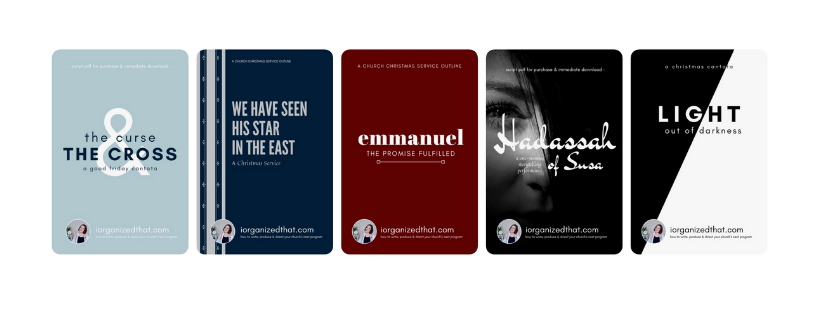I was writing the Quick and Dirty Cheatsheet to Outlining a Church Production (clunky working title of a post coming soon!) and I’ll be honest…
The templates looked too easy.
They were boring.
Someone could look it over and be like “so basic – this is useless”.
So I took a detour which ended up being this post. Here’s how I explain how a super-simple concept became a structured program with just a little thought, structuring, and layers. It’s about the very first script I ever put together and produced – We Have Seen His Star in the East.
At its core, it’s an incredibly simple concept. It became special by adding layers of detail and maintaining both a strong consistency and a good pacing.
Let’s dive into it.

The initial concept:
I wanted to build a Christmas Eve service around the three gifts of the Magi.
- Frankincense for a Deity
- Gold for a King
- Myrrh for a Savior
One other thing that was important to me was incorporating two of my absolute favorite Christmas hymns: “O Come, O Come Emmanuel” and “We Three Kings”. I had noticed that there are some parallels in the stanzas. Since they’re written in the same musical key in my church’s hymnal, I had the idea to go straight from the verse of one song to the parallel in the other song – prophecy and fulfilment, if you will.
What I was working with:
Our church had done primarily simple “sermons with singing and maybe special music” Christmas programs in the years and decades prior. I had to maintain a simplicity in production style to fit in that culture.
Also, we keep the Christmas Eve service under an hour, and about 10 minutes of that closing with candlelighting and “Silent Night” which definitely wasn’t going anywhere anytime soon. Adding in an opening and one congregational hymn, and I had about 45 minutes to work with.
For my personality type, starting with listing known boundaries (event, culture, length, initial concept, etc.) is really helpful. Instead of looking at an unknown empty space that I have to fill with amazing truth, music and words, I can break it down into chunks then attack them individually.
Breaking it down
Our first boundary: time and generic concept. 45 minutes-ish and three sections.
15 minutes per section (yay! Math that I can do).
Let’s plan to have a few minutes at the beginning and end for some sort of opening and conclusion. I don’t have to think what they are at this point, just mark that time allotment and move on. We’ll cut out 3 minutes from each section and leave them in that unknown pile. (All of these budgets can flex and change; this is just getting us rolling).
12 minutes per section.
What I want to include:
A few mini devotionals (less scriptwriting for me which was a wise choice for my experience level), the two hymns, some special music and also Scripture readings.
I wanted similar content types in each section for parallelism, so I might as well create a pattern for each section and check the realistic time expectations:
- Hymns (“O Come, O Come Emmanuel” & “We Three Kings”) = 1:30 minutes
- Devotional = 5 minutes
- Special Music (solo or duet) = 3-4 minutes
- Scripture reading = as needed both for storytelling and for time
***Yes: I timed the special music and also sang the hymns at normal speed, under my breath, in a coffee shop, with a timer running***
New outline
Intro
Section 1: Frankincense for a Deity
- Hymn combo
- Devotional
- Special Music
Section 2: Gold for a King
- Hymn combo
- Devotional
- Special Music
Section 3: Myrrh for a Savior
- Hymn combo
- Devotional
- Special Music
Closing
It’s simple, it’s solid. There is consistency and an intentionality with the layers within each section. While most attendees won’t consciously notice the structure and the level of thought you’re putting into it – the quality is there.
Consistency with variety:
While each section had hymns-devotional-special-music in that order, I broke each section up with Scripture readings a bit differently.
While the purpose of the program was explaining elements of Jesus’ character via the devotionals, it was important to include prophecies, doctrine, and the Christmas narrative also. So I inserted Scripture readings where they best fit the flow of the program, rather than in a set pattern:
Section 1: Frankincense for a Deity
- Scripture Reading
- Hymn combo
- Devotional
- Special Music
- Scripture Reading
Section 2: Gold for a King
- Scripture Reading
- Hymn combo
- Devotional
- Special Music
Section 3: Myrrh for a Savior
- Scripture Reading
- Hymn combo
- Devotional
- Scripture Reading
- Special Music
Now, the program that the congregation was given listed out the names of the speakers and the names of the special music. The rest was in the scripts held by the ensemble. Thus no one without a script was 100% sure when one section exactly ended and another began until they hit those milestones. That way, the program was both (1) seamless and (2) just a touch unpredictable – which is exactly what we want.
Also, mixing up the who-does-what gave some structural variety. The same group of a dozen people did all the readings, ensemble hymn singing, special music, and some of the piano & violin accompaniment.
We mixed and matched throughout so everyone had multiple tasks: one person played piano in one section, narrated Scripture off and on throughout, and sang in a duet also. They sat in chairs on the platform for ease of transition – at any given moment it could be two, or four, or the whole ensemble standing at the row of mics. (Yes, we planned the sitting and standing too – intentionality in all things!)
We created a tight team for ease of rehearsal and communication for these sections, then three completely different people presented the three devotionals.
Intro and conclusion:
A favorite Magi-themed song of mine is “One King” by Point of Grace. I felt that it would compete with a different song I had in mind that was a shoe-in for the closing special music. So I decided to use just the opening of “One King” to set the scene in the prologue:
“Kings of earth
On a course unknown
Bearing gifts from afar
Hoping, praying
Following yonder star
Silhouette of a caravan
Painted against the sky
Wise Men searching
For the Holy Child”
The epilogue was also short – a set of original and Scripture readings – and wrapped all the themes together.
In summary
When you’re preparing a new program from scratch,
- Outline your boundaries & requirements
- Have a theme that you are excited about (not sure? Check out 15 separate concepts outlined here)
- Create a base structure – it’s okay if it’s really simple!
- Assign a flexible timeframe to each main section
- Add layers of parallelism and repetition from section to section
- Include a bit of variety
- Work on filling out each section
And voila! You’re on your way to a thoughtful, well-structured production!

Working on your own Christmas Eve script?
Be sure to visit the Production Guide and also Brainstorm Central, where I give you 15 separate concepts and over 40 different elements you can include in your production!


